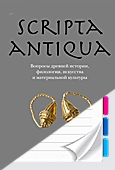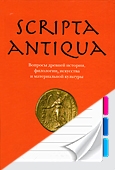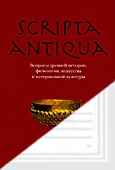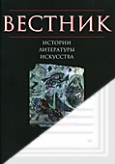Заведующий кафедрой истории древнего мира исторического факультета МГУ им. М.В. Ломоносова.
Ист.: Scripta antique. Вопросы древней истории, филологии, искусства и материальной культуры. Том VIII. 2020. Москва: Собрание, 2020.

Scripta antiqua. Вопросы древней истории, филологии, искусства и материальной культуры. Том VIII. 2020. Москва: Собрание, 2020. С. 330-350.
Статья представляет собой публикацию граффити, найденных во время раскопочных сезонов 2006-2008 годов на городище Чайка в Северо-Западном Крыму. Это в основном торговые метки на керамике, преимущественно на амфорах, акрофонические цифровые граффити с обозначением объема пифосов, ценовые отметки, владельческие граффити. Надписи датируются III-II вв. до н.э. К статье прилагаются новое чтение опубликованного ранее граффито - «посвящения моряков», а также граффити с именами Дионисия и Диоскурида, известные по общим публикациям археологических комплексов Чайки, но не разобранные и не прокомментированные как эпиграфические источники.
S.Yu.Saprykin, E.A.Popova (Moscow). GRAFFITI FROM EXCAVATION ON THE SITE OF TCHAIKA IN THE NORTH-WEST CRIMEA (2006-2008)
The article is a publication of graffiti on pottery, found in course of excavation seasons 2006-2008 in the North-West Crimea on the site of Tchaika which belonged to the chora of Tauric Chersonesus. They are mostly commercial marks on pottery, chiefly on amphoras and kitchen ware, acrophonic numerical graffiti which indicate the capacity of pythoi and amphoras, prices, owners’ marks. Some of them give the owners’ names. The inscriptions are dated to the 3-2 centuries BC. There is also an Addenda where the authors give a new reading of the so-called “dedication of sailors” which had been published earlier, as well as the restoration and commentary of graffiti, bearing the names of Dionysios and Dioscurides. The latter are known from common publications of Tchaika archaeological complexes but were left unstudied and without any commentary as important epigraphic sources.

Scripta antique. Вопросы древней истории, филологии, искусства и материальной культуры. Том VI. 2017. Москва: Собрание, 2017. С. 280–310.
В статье рассматриваются иранские традиции в политике, идеологии и культуре Понтийского царства. Автор отстаивает тезис о том, что первые Митридатиды выдвигали идею о наследственном праве владеть большей частью территорий в Анатолии и Даскилее, так как их предки Отаниды и ахеменидские сатрапы получили эти земли в наследственное владение от Дария I за помощь в ликвидации заговора псевдо-Смердиса (Гауматы). На этой идеологической парадигме выстраивалась их внешняя политика, которая видоизменялась в зависимости от внешнеполитической конъюнктуры, но по сути оставалась прежней. Вследствие того, что означенная версия рассматривалась как официальная, царская пропаганда Митридатидов использовала иранские традиции и культы эллинских богов для обожествления царей, чтобы идея о территориальном расширении царства «по-наследству от предков» получила в глазах подданных и союзников больший политический вес.
S.Yu. Saprykin (Moscow). IRANIAN TRADITIONS IN POLICY, IDEOLOGY AND CULTURE OF THE KINGDOM OF PONTUS
This article is a study of Iranian traditions in policy, ideology and culture (religion) of the Pontic kingdom (Pontic Cappadoce). The author is putting forward an idea that the early Mithridatids of Pontus created the ideological conception of their hereditary right “from the ancestors” to possess the greatest part of territories in Anatolia and Dascyleum. It was based on the fact that the Otanids (named after Otanes, one of the Seven Magi), their direct ancestors, and the Achaemenid satraps as relatives of the Otanids, had got these regions as hereditary land from Darius I for assisting him to suppress the plot, headed by pseudo-Smerdis (Gaumata). This ideological concept was used as background of foreign and internal policy, conducted by the Mithridatids of Pontus. It was mostly used in the early years of the Kingdom of Pontus when the first kings were fighting for independence against the Macedonian rulers and spread power to neighboring areas. But it was exposed to some changes after coming into close relations with the Seleucids and Rome, being impacted by political conjuncture. None the less this ideological version still remained as official, having been only slightly hidden under peaceful and friendly rhetoric. So far as the Pontic dynasts were trying to get sympathy of Anatolian and Hellenic population, necessary for successful expansion to the Black Sea and Western Anatolia, the so-called “royal propaganda” of the Mithridatids used the Greek and Anatolian cults for deifying their kingship, particularly of Mithridates VI. But the Iranian speaking inhabitants could easily identify these deities with the Iranian ones. Such ideological and religious transformation was due to the necessity of keeping on the ancient Iranian idea of hereditary power of the Mithridatids of Pontus over vast territories in Anatolia and the Black Sea.

Scripta antique. Вопросы древней истории, филологии, искусства и материальной культуры. Том IV. 2015. Москва: Собрание, 2015. С. 127-148.

Scripta antique. Вопросы древней истории, филологии, искусства и материальной культуры. Том I. 2011. Москва: Собрание, 2011. С. 294–315.

Вестник истории, литературы, искусства. Том VII. 2010. Москва: Собрание, Наука, 2010. С. 576–586.